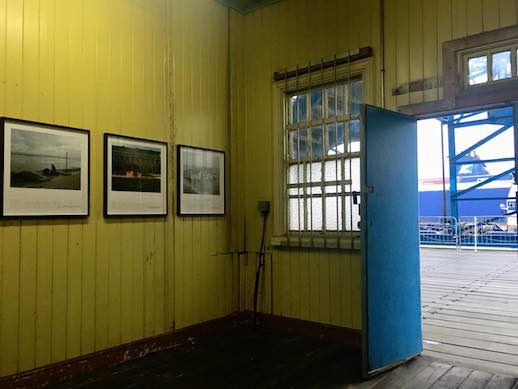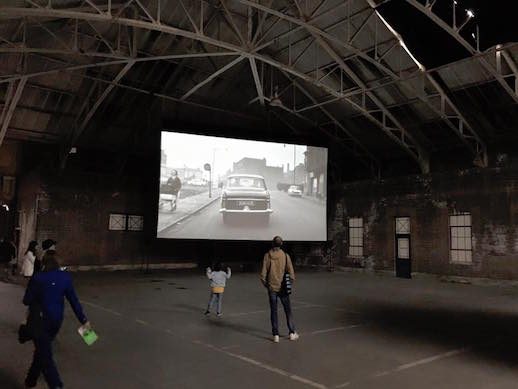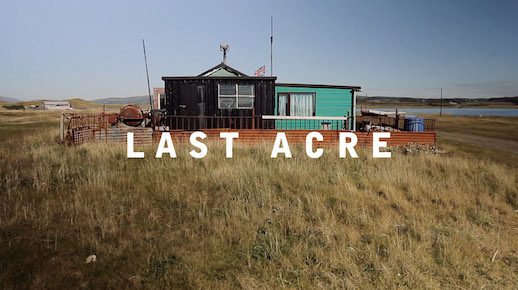Here, with our final report from the recent Estuary Festival 2016, is the writer & filmmaker Michael Smith:
I’d never arrived at an art exhibition by boat before … like some dark and doleful take on the Venice Biennale, we left the forlorn Georgian port of Gravesend, famous as the burial site of plague victims and Pocahontas, and crossed the broad, brooding sweep of the Thames, heading for the Estuary Festival at Tilbury on the opposite bank. We alighted at the festival site, the derelict shell of the ferry terminal which had been the first foot on English soil for generations of immigrants, and the landing spot for HMS Windrush; you couldn’t help but imagine what a bleak welcome it must’ve seemed, this stark, Orwellian, brown brick hall, a cavernous Tate Modern without the refurb, on a soggy stretch of haunted marshland peppered by dockside desolation; “One of the dark places of the earth,” as Conrad’s narrator Marlowe recalls in the opening of Heart of Darkness.
To stage a contemporary art festival in this singularly atmospheric location seemed an inspired move. The idea of art flourishing here like some exotic weed among all the colossal dilapidation reminded me a little bit of how Shoreditch once felt, a derelict wonderland with the all the freedoms of a new frontier. I suppose that just as the old docks had spread from their original heartland of the East End to the farther reaches of the estuary, perhaps in the 21st century they would also be followed by art, London’s creative diaspora fleeing the core and reaching all the way downriver to here, the dirty business end of the Port of London.
The work in the exhibition was suitably unsettling and intriguing, and it generally sat perfectly in the grim, cavernous hall and the series of small wooden rooms beyond it, video work and photography hanging on the cracked, faded, creamy weatherboard, too many good pieces to mention here really.
Highlights for me included Chloe Dewe Mathews’ photo series of people’s spiritual relationships with the Thames – grey haired ladies in a posh pagan ritual by the bucolic banks of the river at Oxford; a Catholic procession over London Bridge, bishops’ hats and incense swinging while the masonic pyramid of the Shard loomed above the waters; Islamic evening prayers, kneeling towards Mecca on mossy concrete flood defences overlooking the estuary mudflats; white robed Africans in a baptism ceremony in the white foam of the pebbly shore at Southend. My favourite image was a Hindu celebration at Richmond, all candles and colourful pigments, immersing a statue of the elephant-headed god Ganesh in the waters; the Thames, like the Ganges, is now considered a sacred river to Hindus, it turns out.
On a completely different tip was Last Acre, a film by Jacob Cartwright and Nick Jordan which asked us to reconsider a layer of our social and architectural heritage that has generally been ignored, scorned or wilfully attacked, the Paris, Texas-style shacks and shanties of the ‘Plotlands’ that sprang up all along the coast of England between the two world wars, a motley, haphazard patchwork of settlements on marginal, neglected land that offered an anarchic alternative to the one way street of modern urban life, a symbolic break with land rules, property regulations, the controlling hand of conformist mainstream society. Out here in the wilds, the margins of land and sea, dreamers and the dispossessed stuck two fingers up to all that, built their precarious, ad-hoc dwellings with their own hands from old boats, railway carriages and whatever was available, discovering self-determination and a strange freedom in those no-mans-lands, reconnecting with nature and the simple life. Local councils hated them for it and have been trying to tear these places down ever since, but the last vestiges manage to stubbornly cling on in the back-of-beyond places like the Essex marshes. To anyone like me who feels a certain fear and loathing at the relentless march of Farrow & Ball or Grand Designs, the thought of these plotlands are an inspiration.
Read our previous reports from the Estuary festival here.
Michael Smith on Caught by the River / on Facebook


